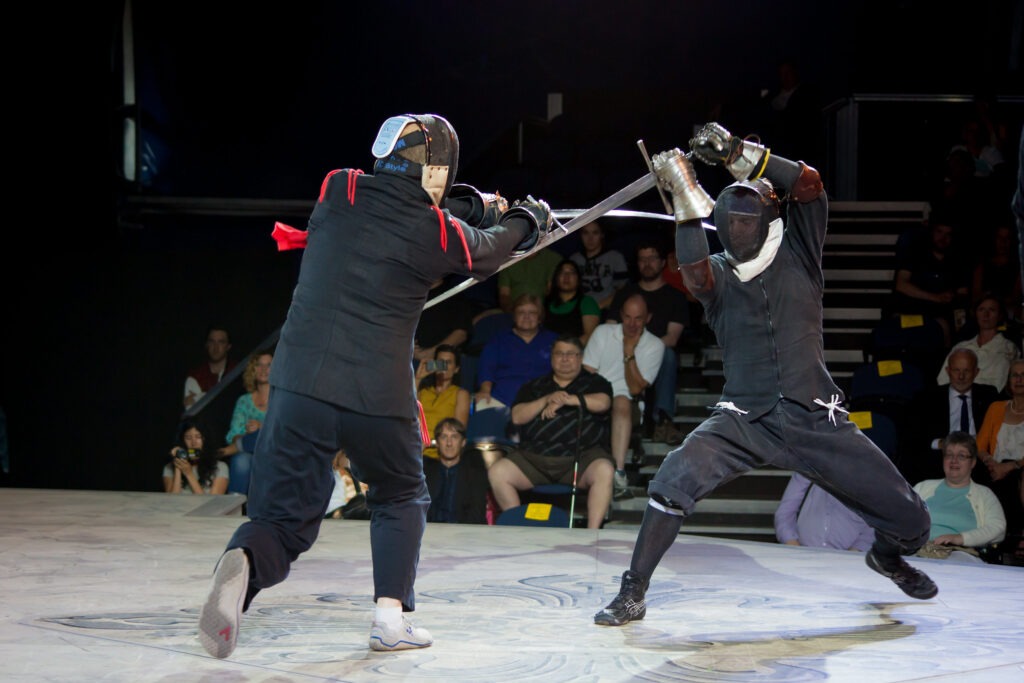When to Go: Four Moments to Strike

Among the foundational concepts in Italian Swordplay is “tempo,” a term that extends beyond mere timing to encompass the rhythm, opportunity, and decision-making critical to combat. A good fighter can see these critical moments, match the rhythm of an opponent, provoke predictable action, and then strike or seize control based on that action.
Today we will explore the basic concepts of tempo as we define them in Duello Armizare, define its four categories, and observe these principles in action through video demonstrations of rapier and longsword sparring.
Understanding Tempo
Tempo is defined as the opportunity to strike an opponent while being safe from their immediate retaliation. This concept is derived from the Italian word for “time” and is closely tied to an opponent’s actions and vulnerabilities. Mastering tempo allows a fencer to exploit moments when an opponent is most exposed—whether due to movement, previous actions, or a lapse in their defense.
The Four Categories of Tempo
Italian fencing theory categorizes tempo into four main types: Contro Tempo, Due Tempi, Mezzo Tempo, and Primo Tempo. Each type represents a different tactical approach to exploiting or creating opportunities during a bout.
1. Primo Tempo (First Time)
In primo tempo, a fencer strikes during a single non-offensive motion of their opponent. Typically as the opponent steps into your measure, or before they’re ready to set up their own attack. It can also be captured as an opponent steps back without covering, or when they freeze in place while in your measure.
2. Contro Tempo (Counter Time)
Contro tempo occurs when a fencer counters an opponent’s attack in a single action, thus attacking and defending simultaneously. This is executed by launching a counterattack precisely when the opponent commits to a strike. This is correctly done with opposition (a counter-thrust or counter-cut that strikes while deflecting the opponents attack), a parry with an alternate weapon (e.g. shield, offhand or dagger), or through evasion (ducking or voiding the body).
3. Due Tempi (Two Times)
This involves two actions to reach the final objective. The first creates a need for the opponent to recover their defense, the second exploits that movement of recovery to strike. This is typically a parry or evasion followed by a ripost. It’s often used when a direct attack is not feasible due to the opponent’s guard or ready position.
4. Mezzo Tempo (Half Time)
Mezzo tempo is executed in “half” the time it takes for an opponent to complete an action. For example, striking an opponent while they are in the process of drawing their weapon back to prepare a strike. This requires sharp timing and keen observation of the opponent’s movements.
Identifying Tempo in Combat
Recognizing the right moment to apply these concepts during a bout is critical. Fencers are inclined to give away certain types of opportunities based on their disposition and strategy.
Primo tempo is often offered by forward motivated fighters who don’t cover their entries or tentative fighters who are willing to let you get too close.
For contro tempo, observe if your opponent is willing to attack when invited. If you can find your opponent’s trigger you can activate it to set up your own opportunity.
Due tempi is useful against opponent’s who are willing to attack but keep their openings well covered. Ideally opponent’s who are seeking primo tempo. Give them an entry, capture their attack and follow their recovery in with your ripost.
Mezzo tempo is offered by opponent’s who over-move in response to your threats. If you find their sword and they wind up to make a big cut, you’re in business to find the mezzo tempo moment in their preparation.
It can be useful to watch sparring bouts, or video your own, and use these categories as a way of learning to see opportunities that a given fighter offers.
Video Demonstrations
I recently filmed some bouts at rapier and longsword with my student Ben Davis. In each of these videos, one with rapier, the other with longsword, I have isolated each strike and labeled it with the tempo and a description of the opportunity taken.
Further Study
Mastering tempo is essential to good fencing. Here are a few resources DuelloTV subscribers can access to deepen their understanding and ability with tempo:
- Course: Striking tempos with Rapier
- Course: Tempo & Provocation with Longsword
For Scholars Live subscribers, the following solo course (3 one-hour classes) with sidesword is a way to dive even more deeply into these topics and explore the exercises that can help you develop your perception and timing.
Not a subscriber yet? Sign-up now to support our work and build your mastery.




